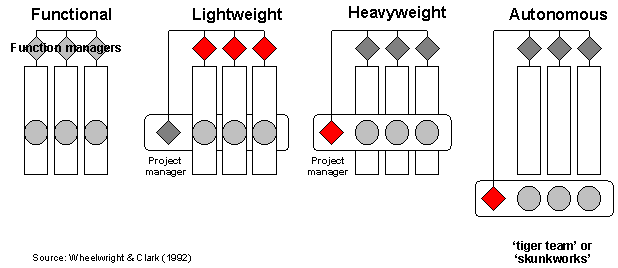Project teams
Most people are educated and trained in a specialism, such as software, electronics, finance etc, and many companies retain these distinctions in the form of departments. This may not be very helpful when it comes to product innovation, which is inherently a cross-functional process. It is possible to recognise a number of possible organisations, characterised by the role and authority of the project leader.

Figure 1: Forms of matrix management
Over the wall
In the 'early days', products were developed by companies with a strong functional organisation and each department would do its bit before handing the project on to the next one. This organisation has come to be known as the 'relay race' system, or rather more unkindly as the 'over the wall' system. The obvious problem with this system is that no one has overall responsibility for the product, giving rise to errors and rework. The sequential nature of the process also discourages concurrent activities. The NPI process is however inherently cross-functional and this has led to a fundamental reappraisal of how it is organised.
Project / program managers
The first change is the appointment of a project manager, responsible for the co-ordination of activities and progress chasing as the project passes through the various phases of the process. This gives rise to various forms of matrix management , in which an individual is assigned temporarily to one (or more) projects while remaining a member of a functional group. This is a compromise solution and can still give rise to conflicts over resource assignments, depending on the relative strengths or seniority of the project manager in relation to the functional managers.
Lightweights and heavyweights
A lightweight project manager is a relatively junior person without the authority to make key decisions, and may have difficulty keeping resource from being 'borrowed' by other projects. The appointment of a heavyweight project manager (also referred to as program manager) is an attempt to redress the balance, giving primacy to the project over the functional division.
Skunkworks
This organisation is associated with radical change. Rather than the team contaminated or constrained by the current company culture, it is set up in a different location, with authority to set its own rules (working hours, dress code, reporting structure etc).

Figure 2: Cross-functional core team (McGrath 1996) |
Cross-functional core teams
Although product innovation is a cross-functional process, it doesn't make sense to have everybody involved in every meeting. The way to handle this is to have a core team with representation from appropriate groups. This might involve say Marketing, Engineering, Production and Service plus designated core team leader.
The core team will follow the product from conception through to product launch and beyond, providing a thread of continuity. Representatives of other groups might take part on a temporary basis as required. Beware of overloading: research suggests that engineer productivity drops as the number of simultaneous project assignments exceeds 2.
Further information
- McGrath, Michael E. (ed) (1996) Setting the PACE in Product Development: a guide to product and cycle-time excellence. Butterworth-Heinemann
- Wheelwright, S. C. and Clark, K.B. (1992) Revolutionising Product Development: Quantum leaps in speed, efficiency and quality, Free Press, New York
For more information, please contact:
T: +44 1223 764830









